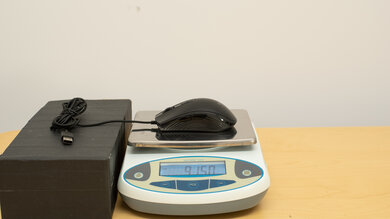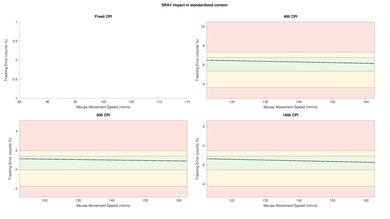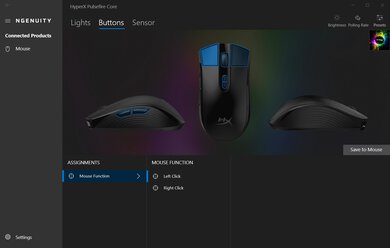The HyperX Pulsefire Core is a good, budget gaming mouse. It feels very sturdy and has an ambidextrous shape with two side buttons on the left. It's suitable for all grip types and nearly all hand sizes, though extra-large hands may extend over the front of the mouse using a palm grip, and small hands may not be able to use the scroll wheel comfortably with a fingertip grip. Performance-wise, it has a somewhat wide CPI range and a low lift-off distance, but the click latency is high for a gaming mouse. Also, the cable and mouse feet are only decent, and the companion software isn't compatible with macOS.
Our Verdict
The HyperX Pulsefire Core is decent for office and multimedia work. It feels very well-made, and it has a good number of buttons you can program using the companion software. Unfortunately, there aren't any wireless connection options, the software is only compatible with Windows, and the scroll wheel lacks L/R tilt buttons and doesn't unlock for free scrolling.
-
Feels very well-built.
-
Ambidextrous; suitable for all grip types and nearly all hand sizes.
-
Software offers customizable options for button mapping, lighting, and sensor settings.
-
Wired-only.
-
Scroll wheel lacks L/R tilt buttons and doesn't unlock for free scrolling.
The HyperX Pulsefire Core is a good FPS gaming mouse. It feels very well-built, and it has an ambidextrous shape suitable for nearly all hand sizes using any grip type. It has a fairly wide CPI range and a CPI you can adjust by increments of 100. It also has a low lift-off distance, though it isn't as low as many other gaming mice. Unfortunately, it has high click latency, and some gamers may prefer a more responsive-feeling option.
-
Feels very well-built.
-
Ambidextrous; suitable for all grip types and nearly all hand sizes.
-
Software offers customizable options for button mapping, lighting, and sensor settings.
-
High click latency.
-
Heavy.
The HyperX Pulsefire Core is satisfactory for MMO gaming, though it doesn't have nearly as many side buttons as a dedicated MMO mouse. That said, it feels very sturdily built, it has an ambidextrous shape suitable for all grip types and nearly all hand sizes, and you can program most of its buttons using the companion software. Performance-wise, it has a high polling rate, a fairly wide CPI range, and a low lift-off distance. Unfortunately, its braided cable isn't very flexible, and it has high click latency for a gaming mouse.
-
Feels very well-built.
-
Ambidextrous; suitable for all grip types and nearly all hand sizes.
-
Software offers customizable options for button mapping, lighting, and sensor settings.
-
High click latency.
-
Not nearly as many side buttons as a dedicated MMO mouse.
Although the HyperX Pulsefire Core scores well for ultra-light gaming, it's significantly heavier than a dedicated ultra-light gaming mouse. That said, it feels very well-built, and it has an ambidextrous shape suitable for most hand sizes using any grip type. Unfortunately, the cable isn't very flexible, and the mouse feet don't glide as smoothly as those on other options. Also, the click latency is high, and it may not feel responsive enough for fast-paced games.
-
Feels very well-built.
-
Ambidextrous; suitable for all grip types and nearly all hand sizes.
-
Software offers customizable options for button mapping, lighting, and sensor settings.
-
High click latency.
-
Heavy.
The HyperX Pulsefire Core is inadequate for travel use as it's bulky and likely won't fit in most laptop cases. It also lacks any wireless connection options, so it can be cumbersome to use in tighter spaces like buses, trains, or planes. That said, it feels very well-made, and there's onboard memory so that you can use your custom settings even on computers without the companion software installed. Unfortunately, you can only save a single profile at a time.
-
Feels very well-built.
-
Software offers customizable options for button mapping, lighting, and sensor settings.
-
Bulky; may not fit in most laptop cases.
-
Wired-only.
- 7.2 Office/Multimedia
- 7.4 Video Games (FPS)
- 7.1 Video Games (MMO)
- 7.0 Ultra-Light Gaming
- 5.4 Travel
Changelog
- Updated Dec 01, 2022: We've converted this review to Test Bench 1.2. This update simplifies our Weight test and expands on our CPI test from Test Bench 1.1, resulting in changes to test results in both sections. For more details, you can see our complete changelog here.
- Updated Nov 17, 2022: We've converted this review to Test Bench 1.1. This update revamps our Click Latency test and results in changes to test results. For more details, you can see our full changelog here.
- Updated Jul 12, 2021: Review published.
- Updated Jun 17, 2021: Early access published.
- Updated May 20, 2021: Our testers have started testing this product.
Check Price
Differences Between Sizes And Variants
The HyperX Pulsefire Core comes in black and has no other color variants. You can see the label for our unit here.
Compared To Other Mice
The HyperX Pulsefire Core RGB gaming mouse is the most affordable model of its type in HyperX's Pulsefire lineup. It's similar to the HyperX Pulsefire FPS Pro but has a different sensor and an ambidextrous shape. It has two buttons behind the scroll wheel, which are CPI switching buttons by default, that can be very useful for quickly shifting between CPI settings in-game. Performance-wise, the sensor is comparable to most other gaming mice at this price point. Still, its click latency is high, and some gamers, especially those playing fast-paced or competitive games, may prefer a more responsive option.
For more recommendations, see our picks for the best cheap gaming mice, the best claw grip mice, and the best gaming mice.
The HyperX Pulsefire Core and the Razer DeathAdder Essential are wired gaming mice with different designs. The Razer has a right-handed design, and its shape is best suited for palm or claw grip for medium to extra-large hands. It has a slightly higher maximum CPI, smoother-gliding mouse feet, and lower latency. The HyperX has an ambidextrous shape with two buttons on its left side, as well as two CPI switching buttons below its scroll wheel. It's better suited for smaller hands who prefer a palm or claw grip.
The SteelSeries Rival 3 is a better wired gaming mouse than the HyperX Pulsefire Core. The SteelSeries is significantly lighter and has mouse feet that glide more smoothly. It also has a higher maximum CPI, a more consistent sensor, a much lower click latency, and customization software for Windows and macOS. Comparatively, the HyperX has two buttons behind the scroll wheel, while the SteelSeries only has one. Unfortunately, the HyperX lacks customization software for macOS. Both mice are suitable for all grip types and nearly all hand sizes, but the SteelSeries accommodates more hand sizes using a palm grip.
The HyperX Pulsefire FPS Pro is a better wired gaming mouse than the HyperX Pulsefire Core. It has an ambidextrous shape and is marginally lighter. It also feels sturdier and has a much wider CPI, a more adjustable CPI, and a much lower click latency. Comparatively, the Core has a right-handed shape and two CPI buttons behind the scroll wheel, rather than just one. Both mice are suitable for all grip types and most hand sizes, but the FPS Pro is likely more comfortable for extra-large hands using a palm grip, while the Core is better suited for small hands using a claw grip.
The Razer DeathAdder V2 is a better wired gaming mouse than the HyperX Pulsefire Core. It's lighter and has mouse feet that glide more smoothly. It also has a much wider CPI range, a more precisely adjustable CPI, a lower lift-off distance, and significantly lower click latency. On the other hand, the HyperX feels sturdier. Both mice are suitable for all grip types and nearly all hand sizes. However, extra-large hands will likely find the Razer more comfortable with a palm grip, and small hands will probably find the HyperX more comfortable when using a claw grip.
The Razer Viper Mini is a better wired gaming mouse than the HyperX Pulsefire Core. It's significantly lighter, and it has a more flexible cable and mouse feet that glide more smoothly. It also has a higher maximum CPI and a much lower click latency. On the other hand, the HyperX has two CPI buttons behind the scroll wheel, while the Razer only has one. The HyperX is suitable for all grip types and nearly all hand sizes, but the Razer is best-suited for a fingertip grip and only suitable for smaller hands using other grip types.
The GLORIOUS Model D is a better wired gaming mouse than the HyperX Pulsefire Core. It has a honeycomb body and is significantly lighter. It also has a much more flexible cable and mouse feet that glide more smoothly. Performance-wise, it has a higher maximum CPI and a much lower click latency. On the other hand, the HyperX feels sturdier and has a lower minimum CPI. Both mice are suitable for all hand sizes, but the GLORIOUS is better-suited for larger hands, while the HyperX accommodates smaller hands better.
Test Results
If you're interested in a gaming mouse with similar performance but with grippy, rubberized side grips, check out the Fnatic FLICK 2.
The polling rate options on the HyperX Pulsefire Core are 125Hz, 250Hz, 500Hz, and 1000Hz.
Comments
HyperX Pulsefire Core: Main Discussion
Let us know why you want us to review the product here, or encourage others to vote for this product.

































